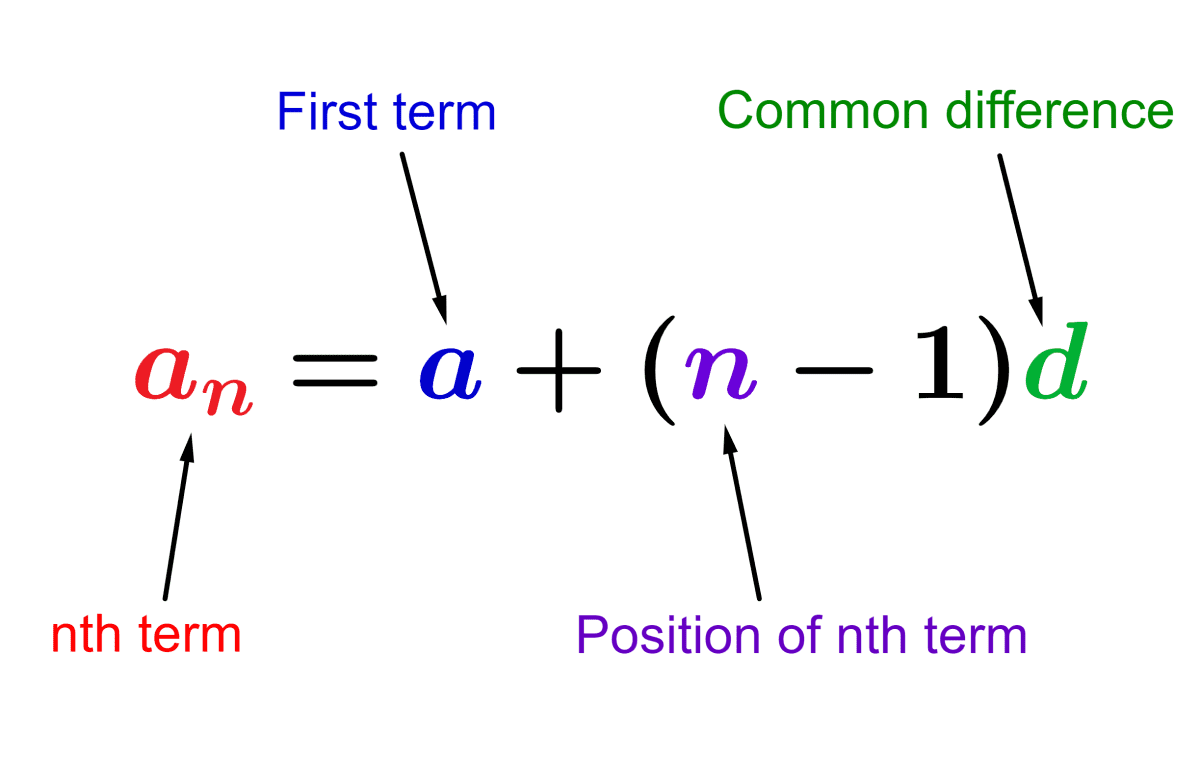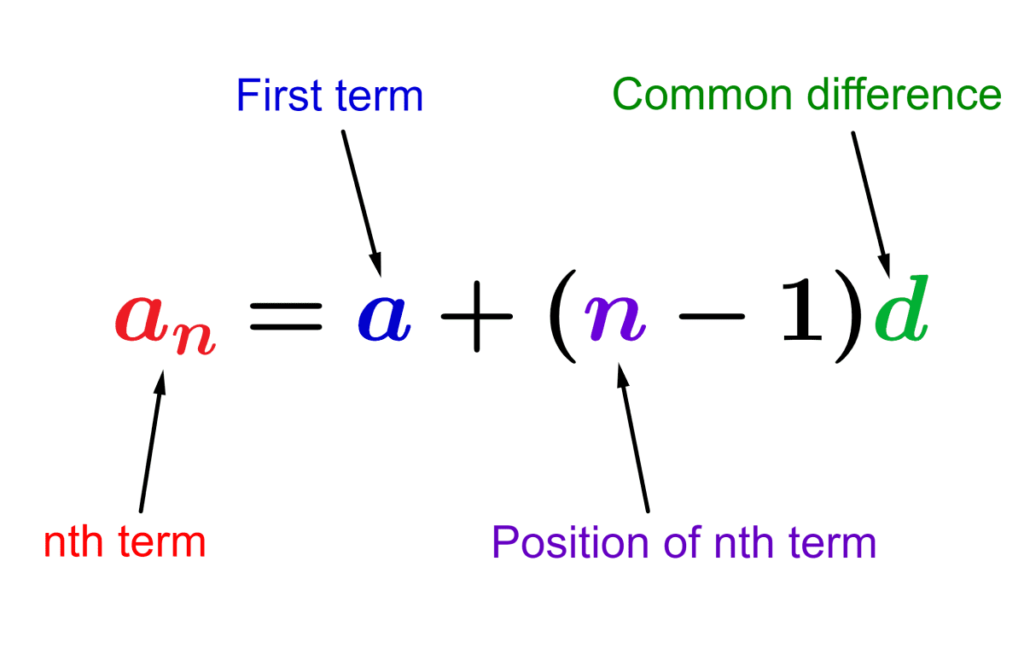The nth term of an arithmetic sequence is found using the value of the common difference, the position of the term, and the value of the first term. We subtract 1 from the term position and multiply by the common difference. Then, we add the value of the first term to find the nth term.
Here, we will solve some examples of the nth term of arithmetic sequences. In addition, you can practice your knowledge of this topic with practice problems.
Steps to find the nth term of an arithmetic sequence
Consider the sequence of numbers 1, 3, 5, 7, … Each term in this sequence is obtained by adding 2 to the previous term. This is an example of an arithmetic sequence.
Arithmetic sequences are sequences in which any term is formed from the previous term by adding a certain number called the common difference.
Generally, the terms of an arithmetic sequence can be obtained using the following formula:
$$a_{n}=a+(n-1)d$$
where,
- $latex a$ is the first term of the sequence.
- $latex d$ is the common difference.
- $latex n $ is the position of the term.

Then, we can take the following steps to find the general term of an arithmetic sequence.
1. Identify the value of the first term.
2. Find the value of the common difference.
The common difference is found by subtracting a term from the sequence by the previous term.
3. Use the formula for the general term.
Substitute the values of the first term, the common difference, and the position of the term into the formula $latex a_{n}=a+(n-1)d$.
10 Examples of the nth term of arithmetic sequences with answers
EXAMPLE 1
Find the value of the 6th term of an arithmetic sequence that has an initial value of 2 and a common difference of 3.
Solution
In this example, we know the values of the initial value and the common difference directly. Also, we know we have to find the 6th term. Then,
- $latex a=2$
- $latex d=3$
- $latex n=6$
Using these values in the formula for the nth term of an arithmetic sequence, we have:
$latex a_{n}=a+(n-1)d$
$latex a_{6}=2+(6-1)3$
$latex a_{6}=2+(5)3$
$latex a_{6}=2+15$
$latex a_{6}=17$
EXAMPLE 2
What is the value of 8th term of an arithmetic sequence in which the first term is 4 and the common difference is 5?
Solution
Similar to the previous example, here we also know the values of the first term and the common difference. Then, we have:
- $latex a=4$
- $latex d=5$
- $latex n=8$
By applying these values in the formula of the nth term of an arithmetic sequence, we have:
$latex a_{n}=a+(n-1)d$
$latex a_{8}=4+(8-1)5$
$latex a_{8}=4+(7)5$
$latex a_{8}=4+35$
$latex a_{8}=39$
EXAMPLE 3
If the first term of an arithmetic sequence is 10 and its common difference is -2, find the value of the 8th term.
Solution
Using the given information, we can identify the following values:
- $latex a=10$
- $latex d=-2$
- $latex n=8$
In this case, we have a negative common difference. However, we can use the same formula, since it also applies in these cases:
$latex a_{n}=a+(n-1)d$
$latex a_{8}=10+(8-1)(-2)$
$latex a_{8}=10+(7)(-2)$
$latex a_{8}=10-14$
$latex a_{8}=-4$
EXAMPLE 4
The first four terms of an arithmetic sequence are 3, 6, 9, 12. What is the value of the 11th term of the sequence?
Solution
In this example, we know the value of the first term directly, but not the common difference.
To find the common difference, we can subtract any term by its previous term. For example, we have $latex 12-9=3$. Then,
- $latex a=3$
- $latex d=3$
- $latex n=11$
Using these values with the formula for the nth term, we have:
$latex a_{n}=a+(n-1)d$
$latex a_{11}=3+(11-1)3$
$latex a_{11}=3+(10)3$
$latex a_{11}=3+30$
$latex a_{11}=33$
EXAMPLE 5
The first four terms of an arithmetic sequence are 10, 6, 2, -2. Find the 8th term of the sequence.
Solution
We start by finding the value of the common difference. Therefore, we have $latex -2-2=-4$. Then, we have the following:
- $latex a=10$
- $latex d=-4$
- $latex n=8$
Applying the formula for the nth term with these values, we have:
$latex a_{n}=a+(n-1)d$
$latex a_{8}=10+(8-1)(-4)$
$latex a_{8}=10+(7)(-4)$
$latex a_{8}=10-28$
$latex a_{8}=-18$
EXAMPLE 6
An arithmetic sequence starts with terms 3, 9, 15, … Find the 9th term of the sequence.
Solution
Finding the common difference, we have $latex 15-9=6$. Therefore, we have the following values:
- $latex a=3$
- $latex d=6$
- $latex n=9$
Using these values in the formula for the nth term, we have:
$latex a_{n}=a+(n-1)d$
$latex a_{9}=3+(9-1)6$
$latex a_{9}=3+(8)6$
$latex a_{9}=3+48$
$latex a_{9}=51$
EXAMPLE 7
Find the 12th term of the arithmetic sequence that starts with the terms 12, 7, 2, …
Solution
The common difference value is $latex 2-7=-5$. Thus, we observe the following values:
- $latex a=12$
- $latex d=-5$
- $latex n=12$
Using these values with the formula for the nth term, we have:
$latex a_{n}=a+(n-1)d$
$latex a_{12}=12+(12-1)(-5)$
$latex a_{12}=12+(11)(-5)$
$latex a_{12}=12-55$
$latex a_{12}=-43$
EXAMPLE 8
An arithmetic sequence begins with the terms -13, -9, -5, … What is the value of 7th term?
Solution
The common difference of the given sequence is $latex -5-(-9)=4$. Then, we have:
- $latex a=-13$
- $latex d=4$
- $latex n=7$
Applying the formula for the nth term with these values, we have:
$latex a_{n}=a+(n-1)d$
$latex a_{7}=-13+(7-1)4$
$latex a_{7}=-13+(6)4$
$latex a_{7}=-13+24$
$latex a_{7}=11$
EXAMPLE 9
An arithmetic sequence has the first four terms: 5, 11, 17, 23. Find the 30th term.
Solution
The common difference of the given sequence is $latex 23-17=6$. Therefore, we have the following information:
- $latex a=5$
- $latex d=6$
- $latex n=30$
Using the formula for the nth term with these values, we have:
$latex a_{n}=a+(n-1)d$
$latex a_{30}=5+(30-1)6$
$latex a_{30}=5+(29)6$
$latex a_{30}=5+174$
$latex a_{30}=179$
EXAMPLE 10
Find the 26th term of the arithmetic sequence that starts with the numbers 20, 17, 14, …
Solution
The common difference of the given sequence is $latex 14-17=-3$. Then, we have the following values:
- $latex a=20$
- $latex d=-3$
- $latex n=26$
Using the formula with the given values, we have:
$latex a_{n}=a+(n-1)d$
$latex a_{26}=20+(26-1)(-3)$
$latex a_{26}=20+(25)(-3)$
$latex a_{26}=20-75$
$latex a_{26}=-55$
nth term of arithmetic sequences – Practice problems


What is the 16th term of an arithmetic sequence that begins with the terms 19, 12, 5, …?
Write the answer in the input box.
See also
Interested in learning more about arithmetic sequences? You can take a look at these pages:




